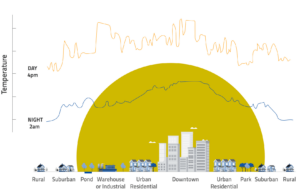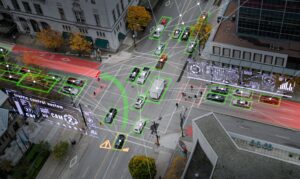Is the future of transportation ripe for a digital transformation or do we still have a long way to go? To find out, EIT Urban Mobility’s Competence Hub sat down with Dr. Massimo Moraglio, author of 100+ publications as well as an experienced tech and mobility consultant in the public and private sector. He is also one of the chief architects and instructors of our upcoming partner course with Technische Universität (TU) Berlin’s Academy for Professional Education on Digitalizing Mobility: Practices, Trends, Solutions and he gave us an exclusive preview of the valuable insights and skills that professionals like yourself can anticipate mastering during this four-week intensive urban mobility course.
You’ve done extensive work on technology’s impacts on mobility. How do you foresee the impact of emerging technologies this year on the future of transportation?
My background is in the history of technology, so I tend to take a long-term view, which looks quite polarised right now. It’s very easy to fall into the trap of believing, “Oh, new technology is very bad” or “new technology will fix everything.” This is just the starting point. As the French philosopher Bruno Latour said, we are a network of humans and artefacts. If we want technology to be more human-centred, it is up to society… and we don’t always accept new technologies, at least not right away. Not all tech comes at the right moment, nor does it work as we might wish it to.
A wonderful example is electric vehicles, which were a large portion of all vehicles in 1905. Then they disappeared, and now they are back. Trams and bicycles are also very old technologies that are coming back. So it’s not a matter of having the best or worst technology. We have to drop our previous notions of Darwinist progress, that the new technologies kick out the old ones. We now come face-to-face with this challenge on a daily basis with telecommunications or IT in mobility, which has already had long and lasting effects.
OK, so this is where the “digital” aspect comes into play. What kinds of long-term effects has IT had on the mobility sector so far?
I think that the real impact is not for everyday users. For example, I can fly to Barcelona by booking my flight and paying online on my phone. I could go today, without any paperwork needing to be printed. It’s incredibly cheaper and easier than even 30 years ago, but this remains just the tip of a very large iceberg where IT can have a positive impact. The problem is that I tried to book a night train between Berlin and Milan, and I ended up having to go to the station in person because it wasn’t possible online. And this was just six months ago!
I think IT is adopted better in “greenfield” sectors than in “brownfield” ones because you have completely new projects, as it was for low-cost airlines in the 1990s. Changing habits of existing and long-lasting transport sectors is incredibly complicated, not just because incumbents have political interests to keep their leverage, but because managers might say, “We’ve been successfully running the service for 200 years, why do we have to change now?” It’s a matter of mindset and competencies, as well as the quality of leadership or investments. The technology will be there but the real point is: How does it fit in existing cases? More and more, we are seeing good IT developments in fields that are less fancy or less “innovative.” For instance, there are already startups trying to change the system but it’s incredibly complicated.
Was that the inspiration for designing this digitalizing urban mobility course? Or is there something else behind it?
That curiosity-driven point of view was the starting point. It comes from the idea that everything in mobility is technological, including walking. Even in a forest, you have a path and often shoes. Everything is built by us but we take it for granted. I noticed that people coming from tech were clashing with people coming from planning because everyone has a different opinion and agenda, despite having a common goal. I thought it was very important to offer a course that gives us a framework for what’s happening, how to connect the dots and have motivation to bring about change. Otherwise, some forms of mobility will have a wonderful online service, like in aviation, but others will have a QR code that says the bus is coming in 3 minutes and then jumps to 20 minutes because who knows why.
Another important part of the course is inviting experts and hosting roundtables about specific topics, like artificial intelligence, for which we don’t know where we’re going nor what the impact will be on mobility or society. This is the beauty of being in Europe: You have an inclusive welfare state — and I would like to keep it that way. But change can be quite a dividing element and we should discuss it as a society, not just as academics or professionals, and take a more strategic view.
How will specific topics, like mobility as a service and digital twins, contribute to this global and strategic view of the course?
These larger visions will be counterbalanced by participants’ personal projects to implement in the real world. We give them the opportunity to develop something very “shop floor,” a very real case, and if they don’t have one in mind, we will provide one. So the syllabus will have this overview and contextualization, along with inviting experts from five or six hot topics, like predictive maintenance, railway signalling or mobility as a service (MaaS), not just for roundtables but also to share their expertise.
There is also the notion in technology and management that advancements often come from copying and pasting ideas from similar sectors. In 2012, the big logistics company Maersk wrote a report suggesting the use of a tracking code for each container, as the aviation sector has for each passenger. The insight isn’t even coming from another field; it’s coming from mobility! You see what the people next door are doing, and you try to develop that. Even if you come from, let’s say, the railway sector, understanding what’s happening in MaaS or public transport can be very interesting for your job because you can learn from peers.
Can you talk a little bit more about how participants will be encouraged to take creative and maybe unconventional approaches to those personal projects? How will the course encourage them to take more risks and think more critically?
The contextualization part of the course is very lofty, so the personal project then gives it gravitas to keep them very grounded in terms of real output. It also leverages the capacity of people to look around a little bit for better solutions, which will be important for upskilling and reskilling. This kind of discussion isn’t happening enough because it’s hard to get people out of their comfort zone, especially when you have to develop a project, a deadline, a budget… These can kill creativity and critical thinking.
That’s why we decided to copy other sectors, like how architectural faculties have a studio approach, and give learners one week to really think, discuss and chit-chat about their project. On the Monday of that week, we will focus on the pain points for users (who are very important, especially in public transport, where the mindset tends to be product-driven and not customer-driven). Then on the second day, learners will develop a possible solution, maybe even two. But that’s not enough because the solution needs legs. So day three will cover managerial and budgetary points of view to see if the solutions are feasible. On the fourth day, we will try to connect these three pillars, and finally, on Friday morning, everyone will have, as Andy Warhol said, their “15 minutes of fame” to present their outcome to an audience.
So the course ends with a bang, very nice! What happens next? What do you hope learners will do after they complete the course?
We have so many problems in urban mobility and we need innovative ways of thinking about and moving around the city. I think we should be more open to radical solutions, specifically when it comes to the user perspective: attempts to decarbonize city transport are already facing mounting resistance. The case of the yellow vests in France also shows us that without social inclusion and a good way of presenting technology to society, it will be even more misunderstood. We have to keep everyone in mind or else we will have technology that works very well for, like I mentioned, booking a plane ticket, but this is only 20% of the European population.
While this course is short, we will touch several people and help them reframe the mindset of tech and mobility when it comes to public policy, companies and even NGOs. I will be very happy if the participants leave the course and say, “I’m thinking of my job or my project in a different way now” and maybe in two years they will take a whole new approach. For me, that would be a big success.
For more information or to apply to this course click here and embark on a journey towards reshaping the landscape of urban transportation.
Course Title: Digitalizing Mobility, Practices, Trends, Solutions
Course Date: 07.05.2024 – 31.05.2024

Adina Rose Levin
Adina Levin was born and raised in Chicago, and clocked in over 10 years in New York City before moving to Barcelona. As a freelance writer and creative strategist, she explores cities, culture, media and tech.

Dr. Massimo Moraglio
Dr. Massimo Moraglio, author of 100+ publications as well as an experienced tech and mobility consultant in the public and private sector. He is also one of the chief architects and instructors of our upcoming partner course with Technische Universität (TU) Berlin’s Academy for Professional Education on Digitalizing Mobility: Practices, Trends, Solutions



